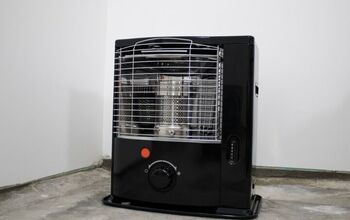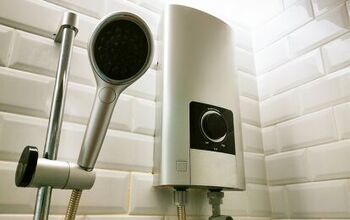Infrared Vs. Ceramic Heater: What Are The Major Differences?

When the winter weather hits, there are times when our HVAC system just doesn’t cut it. We could do with a little extra oomph from a space heater. Knowing how a heater produces heat helps to make the right purchase for your needs.
Ideal for heating large spaces, ceramic heaters warm up quickly and circulate heat throughout the room. They tend to be cheaper and more portable than infrared heaters. However, they are also noisier.
Infrared heaters heat objects, not the air. You must be directly in their path to feel their heat. They are more energy-efficient, safer, and quieter than ceramic heaters.
Do You Need a Heating and Cooling Contractor?
Get free, zero-commitment quotes from pro contractors near you.

Infrared vs. Ceramic: How They Work
Electric heating methods come in two types: radiant and convection. They disperse heat differently. So, it’s important to understand how they work to ensure you’re getting the ideal heater for your needs.
Infrared heaters produce radiant heat. Similar to the sun, they heat objects directly in their path without relying on airflow to maintain the temperature.
With an infrared heater, you can keep a window open on a cold day and still feel the same level of heat—so long as you’re in its path. For this reason, infrared is a popular choice for patio heaters.
Typically, ceramic heaters are a kind of convection heater. They produce heat by circulating air over a hot surface and then blowing it into the room. In this case, ceramic heaters heat the air, not the object. You can be sitting anywhere in the room and feel the warmth of a ceramic heater.
Ceramic heaters can also produce radiant heat. In this case, they won’t have a fan to blow the air throughout the room. Rather, electricity heats the ceramic plates and slowly radiates the heat around the room.
Infrared Heater Pros
Infrared heaters offer many advantages. They produce constant, consistent temperatures that remain unaffected by the room’s insulation. In addition to their energy efficiency, they cut down on noise and air pollution.
Direct Heating
Perhaps the strongest advantage of infrared heaters is their ability to keep a cold space comfortable. Because they warm the objects and not the air, any drafts become obsolete. You won’t feel the effects of poor insulation when in the direct path of an infrared heater. This makes them the popular choice to heat garages and workshops.
Energy Efficient
Not only do infrared heaters manage well in drafty garages, but they are also the better choice for prolonged use in indoor spaces. Infrared heaters use 30 to 40% less energy than convection heaters.
If you spend a lot of time in one room of your house, an infrared heater is a more efficient choice. You’ll save money and stay warm!
No Noise Pollution
Noise pollution is the constant humming noise you hear from fans or heaters with fans (i.e. convection heaters). There’s none of that with infrared heaters. Because they don’t rely on fans, they are completely silent when operating.
On the downside, they do contribute to light pollution. The UV rays they produce to heat objects aren’t as invisible as you’d think. Infrared heaters give off a yellowish glow when operating which can be annoying to some.
No Recycled Air
Convection heaters use the same air all day long. You can’t open a window to allow in fresh air unless you want the heat to escape.
Recycled air really isn’t all that great. It can cause severely dry skin and even lead to illness. Not to mention any allergens in the air are constantly reintroduced into the room.
Because infrared heaters don’t rely on air to produce their heat, they aren’t constantly recycling the air in the space. You have the ability to open the window to allow in fresh air without sacrificing the heat level.
Low Maintenance and High Safety
Infrared heaters are free of filters, fans, motors, or other moving parts that can break down and require maintenance. They also don’t get as hot as convection heaters, and their heating element is often covered in a way that prevents burns.
Ceramic Heater Pros
Because ceramic heaters can be either convection or radiant, they come with many benefits. They’re fast to heat up—especially when they’re equipped with a fan—and cool down just as quickly. You can take ceramic heaters from room to room as they’re easily portable.
Varying Heat Types
When most people hear ceramic heater, they think of a convection heater where a fan disperses the air into the room. This is probably the more common type of ceramic heater.
However, some ceramic heaters produce radiant heat. These disperse air with the direct heating method of infrared heaters. But it takes longer for radiant ceramic heaters to warm a room.
Warms Up Quickly
Because ceramic as a material is a partial heat conductor, a ceramic heater warms a room up quickly. This is particularly true of ceramic heaters with fans.
Cools Down Quickly
As soon as a ceramic heater is shut off, the heat production stops. It doesn’t take much time at all for a ceramic heater to cool down. This is a wonderful safety feature. Although they can be hot to the touch while running, the cool-down time of ceramic heaters keeps them from being a fire hazard.
Portable
The ceramic plates used as the heating element are small and don’t impact the overall weight too much. This means that ceramic heaters are quite portable. You can take them anywhere you might a little extra heat.
Between their portability and convection design, putting a ceramic heater in a strategic location might cover a wider area with heat. This makes for quite the efficient heating option, though not as efficient as an infrared heater.
No Light but Some Noise
Unlike infrared heaters, ceramic heaters create no light pollution. They don’t give off any light unless they have a digital thermometer.
However, their fans create noise pollution. This constant hum or buzz can be irritating if you’re watching TV or trying to sleep.
Budget-Friendly
Bonus! Ceramic heaters tend to be less expensive than infrared heaters. However, you may end up spending a bit more on your energy bill. So, it’s kind of a toss-up.
Infrared vs. Ceramic: Energy Efficiency
Both types of heaters claim they are energy efficient, which is true. We’ve stated that infrared heaters use 30 to 40% less energy than ceramic heaters. Let’s break down why this is.
Infrared heaters can be powered by electricity, gas, and other types of fuel. Ceramic heaters can only be powered by electricity. We also know ceramic heaters can produce radiant or convection heat. Let’s assume for the purpose of comparison that we’re talking only about electrically powered, radiant heaters.
An infrared heater uses 100% of the heat produced with no air loss. All of the heat produced is being absorbed by the objects in the room.
Radiant ceramic heaters take longer to heat the space. The heat radiates toward the object only after the heating element is warm enough. This process means the space takes longer to feel warm.
It also means radiant ceramic heaters use more energy. The longer the heater has to run the more energy it’s using, which, in turn, raises your energy bill.
On the other hand, a convection ceramic heater warms the room up faster because of its fan. However, it’s still less energy-efficient than an infrared heater. An infrared heater uses 7 watts of electricity per square foot while convection heaters use 10 watts.
Related Questions
Can an infrared heater heat a room?
The short answer is yes. Infrared heaters heat objects, not the air. So, if you aren’t directly in its path, you won’t feel as much of its heat. But the walls of the room play an important part here. Walls are objects, too, and therefore can absorb heat which raises the temperature of the room.
Can an infrared heater cause a fire?
Most space heaters cause fires because dust or lint comes in contact with the heating element, likely the fault of the fan. Infrared heaters have no fan, and therefore don’t blow air or allergens in the air. On top of that, an electrically powered infrared heater doesn’t use fossil fuels. These are notorious for emitting highly flammable air pollutants. It’s unlikely that an infrared heater will cause a fire.
Are ceramic heaters safe for garages?
Ceramic heaters are safe to use in garages when the room is occupied. It’s never safe to leave a heater on and leave the room.That being said, ceramic heaters aren’t the most effective option for heating a garage. Garages aren’t known for their good insulation. And because ceramic heaters heat the air, the temperature might not get as comfortable as you’d like.
Do You Need a Heating and Cooling Contractor?
Get free, zero-commitment quotes from pro contractors near you.

Summary
An infrared heater is more efficient but it relies on direct heating. A ceramic heater warms and cools quickly but is affected by things like open windows and poor insulation. An infrared heater is better for your health, but a ceramic heater is portable and less expensive. The type of heater you purchase truly depends on what you want out of it.

Brigid Levi is a wife, mother, and freelance writer who enjoys a good DIY project and creating beautiful spaces within her home. From cleaning and organization hacks to home decor ideas, she loves helping people in their quest to turn a house into a home. Her hobbies include pretending to be Joanna Gaines while updating her home with her husband and performing in local theater productions.
More by Brigid Levi

















![How To Reset A Whirlpool Cabrio Washer [In 5 Easy Steps!]](https://cdn-fastly.upgradedhome.com/media/2023/07/31/9076531/how-to-reset-a-whirlpool-cabrio-washer-in-5-easy-steps.jpg?size=350x220)









